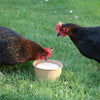
The Natural course of the moult in pigeons
Not one good breeder will underestimate the great value of a normal (ie regular and complete) moult. The moult is a natural phenomenon and it is precisely the healthy animals that moult completely and completely, that is to say, at a fixed regularity and in a fixed order, to get rid of their old feathers and to grow new ones in their place.
The health of the pigeon is decisive for a good moult
How the moult proceeds depends entirely on the physical condition of the pigeon, which can be influenced by, for example, late breeding or inadequate housing, but also mainly by disease.
With one pigeon the moult is easier than with the other, so there are also pigeons among them that visibly suffer from it. As far as housing is concerned, the pigeons should in the first place be bone-dry and draft-free, otherwise you can never count on a smooth moult. The moulting takes place with regularity, at least when the pigeon is in 100% condition and nothing has exerted a disturbing influence on it.
The smallest things such as a light period, a sudden change of food or a night in the gutter can stop the moult or at least interrupt it. And although this interruption is short, it is reflected in the pigeon's new flight feathers. Every connoisseur and judge will immediately notice this. In these cases, the cascading order of the flight feathers is irregular, while every misfortune the pigeon has gone through left a mark on the currently ingrown feather. Known as transverse stripes, transparent and serrated. They are evidence of illness, in any case of less good condition, of stagnation in the moult.
Everything that the pigeon has experienced during the moulting period can be seen in the flight feathers. A normal moult is of great importance. The goal should be; a regular, uninterrupted and flawless full moult.
The course of the moult
It is not as noticeable as in the months of August, September and October, but the moult lasts throughout the year. And certainly in the period when the pigeons no longer lay nests and have no exhibitions, it is important to give them some extra attention. During the large moult that starts in July or August, it is necessary that the pigeon has completely calmed down.
At the first brood, the pigeons emit their first flight feather, the first of ten, the last of which can only fall in September or October. The end of the moult occurs with the fall of the last outer flight feather. This is a critical moment for the pigeon, because the pigeon's vitality is often at zero, the pin often comes out of the shaft with difficulty.
The wings
Each wing has 10 flight feathers and 12 auxiliary flight feathers. Which are slightly wider and more rounded in the cock than in a hen, these are often narrower and more pointed. The flight feathers renew first, only when this has been successful the auxiliary flight feathers follow. This is because otherwise the bird can no longer fly.
The tail
In normal breeds, the tail consists of 12 feathers, divided into two equal rows of six each. The moulting of the flight feathers lasts from spring, throughout the summer, the moulting of the tail often starts after the moulting of 7 to 8 flight feathers. When the last flight feather has grown in in the autumn, the last tail feather has also been replaced by a new one and the moult is complete.
The tail feathers are changed in pairs, when they are three quarters fully grown the next ones start. This is faster than a firing pin.


